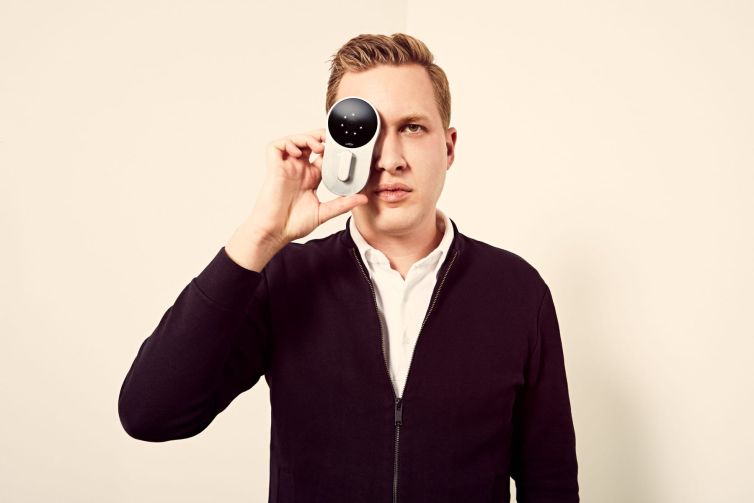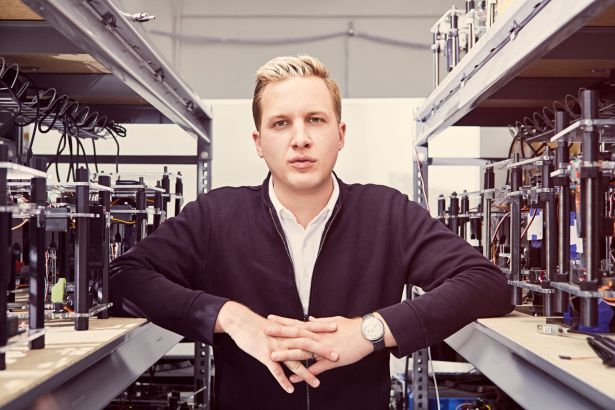How Latch CEO Luke Schoenfelder Unlocked the Secret of a $1.5 Billion Valuation
Latch will go public via a Tishman Speyer-sponsored SPAC
By Chava Gourarie April 19, 2021 12:00 pm
reprints
Luke Schoenfelder can credibly claim to be the world’s first billion-dollar locksmith.
Actually, that’s not quite right. Schoenfelder is close to being a $1.5 billion locksmith. That’s the valuation of Latch, the company he founded, as it prepares to go public through a special purpose acquisition company (SPAC) sponsored by Tishman Speyer.
Schoenfelder has been convincing people of his vision for quite a while, though he’s only 32 years old, but getting that valuation in 2021 feels like something special.
Schoenfelder convinced his friend Ali Hussein to move to New York to join his startup back in 2015. He convinced friends and colleagues to bet on his vision. He convinced investors that he could execute on that vision. Now he just needs to convince the public.
Hussein’s stint at Latch was supposed to be for just a few months. He had left his job at a consulting company to to help the startup get its first prototype to product-market fit.
But he stayed and never left Latch, where he is now the chief operations officer.
“[Luke] has this amazing ability to use the people he’s met throughout life,” Hussein said. He doesn’t mean “use” in a pejorative sense. Collect. Befriend. Collaborate. That’s more what he means. “He’s not out just trying to hire his buddies, but he has this amazing acumen of picking up talent.”
Schoenfelder, originally from rural Pennsylvania, started Latch in 2014 in Washington, D.C., along with three co-founders. Their first office was above Kramers, a bookstore in Dupont Circle, where Schoenfelder pitched investors on his vision: one key to open every door. Latch software would allow anyone to access any Latch-wired door with their phone.
Since then, Latch has matured into a company valued at that $1.5 billion in the SPAC sponsored by Tishman Speyer, an early customer and investor. In addition to Tishman, Latch clients include Brookfield Properties and AvalonBay Communities, two of the largest landlords in the country, and the technology was installed or booked to be installed in 304,000 homes at the end of 2020, double the amount from the previous year.
And, like any good startup founder, Schoenfelder sees his company as something transformative. It’s not only a point solution for access into buildings for owners and residents, but an operating system for the entire building, one that will eventually be able to manage all the digital aspects of the property, from package delivery to maintenance, rent payment to internet installation — or one platform to rule them all, if you will.
Digital access was just the way in. “When I saw the problem with access, for me, it was all about how you could build this new type of infrastructure that would make buildings better places to live in,” Schoenfelder said.
Schoenfelder’s path to startup founder was not entirely linear, though he knew early on that he wanted to start a company that would make a big difference. He studied public policy at Georgetown University, and then studied innovation, entrepreneurship and management at Imperial College in London as a Marshall Scholar.
Despite the name of the program, it wasn’t the most entrepreneurial of places to be, said Si Dhanak, a general manager at Latch and Imperial College classmate, who said Schoenfelder stood out in the environment. “He was always known at Imperial College as the archetype of the American entrepreneur,” Dhanak said. “We were in the U.K., where it’s a conservative atmosphere, and he brought this kind of can-do attitude.”
During college, Schoenfelder worked at Apple, a company he deeply admired, in public policy and worldwide government affairs. But he left after he finished college to follow his real passion. “I really wanted to go and build something on my own,” Schoenfelder said. “I was very passionate about infrastructure problems and building things at scale that could serve a lot of people.”
By 2013, Schoenfelder had a couple of failed startups under his belt, including an energy management company called GridPotential and a smart luggage company. After the energy company failed, he considered getting a regular day job, but instead focused his attention on access.
Schoenfelder teamed up with Brian Jones, his co-founder at GridPotential; Thomas Meyerhoffer, a designer who had worked at Apple; and an entrepreneur he’d recently met, Dhruva Rajendra, to start Latch. From his Apple days, Schoenfelder had an appreciation for companies that controlled both the hardware and software aspects of an experience, and also a Jobsian approach to the primacy of design.
Around 2014, in search of seed funding, Latch pitched Camber Creek founder Casey Berman in their D.C. office. They had no pitch deck, but they did have a handful of hardware prototypes in the office. Berman liked what he heard, and he liked what he saw in the team: ambition and clarity. “One thing was incredibly obvious in the first pitch: they had extreme clarity as to what the future would look like,” Berman said.
More specifically, he liked the idea of a unified system. “They had a number of really incredible ideas, but they all hinged around this idea of access, and streamlining access,” he said. “It was in that moment, we saw this just massive opportunity.”
Camber Creek leveraged its network, the majority of whose members are institutional real estate companies as limited partners, to get Latch into its first properties in New York, where the company moved in 2015 from D.C.

That’s when Schoenfelder reached out to Hussein, who he knew from his days in London, when both were Marshall Scholars at different universities. At the time, Latch was a team of about 10 people, subletting office space and close to running out of seed funding. Hussein found housing in a deal that highlighted the quirks of New York City’s housing market.
In exchange for unreasonably low rent, all Hussein had to do was pretend to be the son of the Pakistani owners of the apartment, a co-op unit that could only be occupied by family. The son’s name was Ali Hassan, so with his name just one letter off and his looks — his parents are also Pakistani — it was easy enough for him to pass.
In the end, he stayed long enough that the doorman caught on and played along, letting Hussein get packages and invite friends over, including Schoenfelder. “It’s one of those funny New York experiences where, ultimately, it’s about the social contract,” Hussein said.
But, most of the time, the team was at the office. They were designing their first lock, a mortise-style lock used for apartment doors (now called Latch M), that not only had to be perfectly designed, but also lay the groundwork for the longview of Latch as more than an access solution, said Hussein.
At one point, he and Schoenfelder had a tense debate because of the latter’s focus on the longview. The mortise lock was ready to ship, but the electronic reader, which would be installed in public areas like lobbies and garages, was not. So, Schoenfelder wanted to wait and hold off on shipping.
“That’s crazy, Luke,” Hussein told Schoenfelder. “We haven’t even shipped our first product.”
“No, you’re thinking about this wrong,” Schoenfelder replied. “It’s not about selling a single lock.”
It was about selling a seamless experience.
“It comes down to some of these basic principles: you build a hardware infrastructure — whether Peloton is building physical bikes, Tesla’s building cars, Latch is building locks — but what’s interesting about all of these companies is the software and the services that sit on top,” Dhanak said.
By 2018, Latch was far enough along in their process to start pitching and signing clients, including Tishman Speyer, which piloted the system in a new development in Boston. Later that year, Tishman invested in the company in a $70 million Series B round led by Brookfield Asset Management. By the end of the year, Latch was installed or booked to be installed in 45,000 homes.
Tishman had previously launched an in-house product to manage amenities in their office properties called Zo, and was looking for something on the residential front. “Luke has a tremendous real estate IQ for someone who wasn’t originally trained in the industry,” said Tishman CEO Rob Speyer, who first met Schoenfelder in 2017 at an investor presentation. “He has a very forward-leaning vision about the future of the industry and, in particular, what our customers want.”
While Latch had tapped into what developers like Speyer were looking for — a single platform to manage their properties — at the moment, Latch remains a point solution for access.
That covers quite a lot of ground on its own. In addition to moving seamlessly within the property, using your phone to open your own door as well as all the public spaces, Latch allows building owners and residents to manage a host of services from their phones: package delivery, guest management, maintenance visits, lock changes and apartment tours to name a few.
Starting in 2017, Latch partnered with UPS to provide access to buildings when residents are not at home, and has since rolled it out to 12 cities.
Even if Latch were to remain a point solution, the addressable market is significant. There are roughly 32 million apartment units in the United States, according to Latch’s estimate (plus 15 million single-family rentals), and Latch has less than 1 percent penetration into that market.
However, the apartment stock in the United States is fairly old, which could limit how far Latch can go. More than 75 percent of apartments in the United States are more than 20 years old, and more than half were built prior to 1980. As for new development, there has been an average of just 382,000 units added each year since 2016, according to U.S. Census data.
But Latch has been designing for retrofits, Schoenfelder said. “A lot of the team came from Apple, a lot of us are focused on product design, and it’s been, ‘How do we solve for that?’ Because if we want people in old buildings to use the product, we have to design for that use case.”
Two examples: Latch offers an intercom system that residents can answer with their phone from anywhere, but it requires an internet connection. In order to allow their intercom to be used by older buildings, the company designed an outdoor product that could provide the necessary internet connection without rewiring the building. More recently, Latch launched its C2 line of locks that are designed to fit older doors, which tend to get misaligned over time.
“We designed for imperfection,” Schoenfelder said. “And we designed our systems to work in old buildings, because we know most people live in old buildings.”
Schoenfelder grew up in a building that is older than the country itself, on a farm in Lancaster, Pa. It was originally a structure known as a “spring house,” built over a natural spring in 1763. “It started off as a shed that got upgraded to a house, and then they just kept building onto it,” Schoenfelder said.
As of now, Latch is working on a variety of projects, including a publicly subsidized project in Baltimore, walkups in Brooklyn, and garden-style apartments in Ohio and Indiana. “Luke’s always driven, from the beginning of the design, for universality,” Hussein said.
In 2019, Latch expnded its Series B with another $56 million at a valuation of $400 million, and closed the year with 145,000 Latch-enabled units. In the fall of that year, long before the SPAC boom that would explode in 2020, Schoenfelder got its first SPAC offer, but with their Series B round, they had no need to consider more funding.
“2020 was a fairly wild year in lots of places; the SPAC inbound started to really increase and, ultimately, over the summer, we started to just be inundated with SPAC inquiries,” Schoenfelder said.
In the end, Latch chose to partner with Tishman Speyer because they felt they were most aligned, and because Tishman could offer them entry into Europe and into the office sector. “It was really about thinking long term and focusing on making buildings better places to live, to work, and to visit around the country, in different asset classes, and then around the world,” Schoenfelder said.
“Tishman Speyer in their office product, they have the Zo platform, which is a similar idea of an operating system for buildings, for office buildings,” Camber Creek’s Berman said. “So, we’re really excited about the philosophical alignment of the Tishman team.”
Tishman had raised a $300 million SPAC, called TS Innovation Acquisition Corp. (TSIA), targeting proptech companies in November of last year, and announced the merger with Latch in January. The deal raised an additional $190 million in private investment, and valued Latch at $1.56 billion. When the merger is completed — which usually occurs within 90 days of the merger announcement — the company will begin trading under the ticker LTCH.
Part of Latch’s pitch is that they’re early enough in the game to become the dominant operating platform, but whether they will achieve that in an emerging marketplace remains to be seen.
In Latch’s financial materials shared during the SPAC process, the company often highlighted the amount of times that users open its app: at the moment, it’s an average of 4.6 times a day. That’s because that level of engagement is highly prized, and could lead to residents using the platform for more and more services.
The idea is that if you build an app that people will need to engage with regularly, and offer them a great experience, they’ll keep coming back for more, Schoenfelder said. “It creates this, you know, flywheel, if you will, of people having a better experience wanting to try the next thing that is more efficient and more enjoyable.”
It gets back to Schoenfelder’s original interest in infrastructure on a scale that can transform something as fundamental as housing, combined with a sprinkle of the Silicon Valley insistence that technology that offers convenience will make the world a better place.
“No real estate company can actually build this stuff on their own, they don’t have the expertise, they don’t have the financial resources,” Schoenfelder said. “And, so, this is a really important function that we play in creating this better infrastructure for everybody in the industry.”
“Luke always had this long view about creating the ultimate experience to get adoption and a delightful end-to-end experience in a building,” Hussein said. “Those are the kinds of things that kind of drew into that ultimate vision from the beginning, even when we were a six-person company, and I think will continue to drive us with a 600-, or hopefully, one day, a 6,000-person company.”


